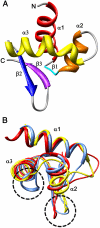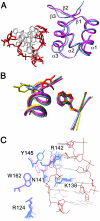Solution structure of the Zbeta domain of human DNA-dependent activator of IFN-regulatory factors and its binding modes to B- and Z-DNAs
- PMID: 21471454
- PMCID: PMC3084098
- DOI: 10.1073/pnas.1014898107
Solution structure of the Zbeta domain of human DNA-dependent activator of IFN-regulatory factors and its binding modes to B- and Z-DNAs
Abstract
The DNA-dependent activator of IFN-regulatory factors (DAI), also known as DLM-1/ZBP1, initiates an innate immune response by binding to foreign DNAs in the cytosol. For full activation of the immune response, three DNA binding domains at the N terminus are required: two Z-DNA binding domains (ZBDs), Zα and Zβ, and an adjacent putative B-DNA binding domain. The crystal structure of the Zβ domain of human DAI (hZβ(DAI)) in complex with Z-DNA revealed structural features distinct from other known Z-DNA binding proteins, and it was classified as a group II ZBD. To gain structural insights into the DNA binding mechanism of hZβ(DAI), the solution structure of the free hZβ(DAI) was solved, and its bindings to B- and Z-DNAs were analyzed by NMR spectroscopy. Compared to the Z-DNA-bound structure, the conformation of free hZβ(DAI) has notable alterations in the α3 recognition helix, the "wing," and Y145, which are critical in Z-DNA recognition. Unlike some other Zα domains, hZβ(DAI) appears to have conformational flexibility, and structural adaptation is required for Z-DNA binding. Chemical-shift perturbation experiments revealed that hZβ(DAI) also binds weakly to B-DNA via a different binding mode. The C-terminal domain of DAI is reported to undergo a conformational change on B-DNA binding; thus, it is possible that these changes are correlated. During the innate immune response, hZβ(DAI) is likely to play an active role in binding to DNAs in both B and Z conformations in the recognition of foreign DNAs.
Conflict of interest statement
The authors declare no conflict of interest.
Figures



 with CG6 (Left) and hZβDAI with AT6 (Right) (α, purple, disappeared; β, blue, ≥0.10 ppm; γ, light blue, ≥0.075 ppm; δ, cyan, ≥0.05 ppm).
with CG6 (Left) and hZβDAI with AT6 (Right) (α, purple, disappeared; β, blue, ≥0.10 ppm; γ, light blue, ≥0.075 ppm; δ, cyan, ≥0.05 ppm).Similar articles
-
The crystal structure of the second Z-DNA binding domain of human DAI (ZBP1) in complex with Z-DNA reveals an unusual binding mode to Z-DNA.Proc Natl Acad Sci U S A. 2008 Dec 30;105(52):20671-6. doi: 10.1073/pnas.0810463106. Epub 2008 Dec 18. Proc Natl Acad Sci U S A. 2008. PMID: 19095800 Free PMC article.
-
The Zβ domain of human DAI binds to Z-DNA via a novel B-Z transition pathway.FEBS Lett. 2011 Mar 9;585(5):772-8. doi: 10.1016/j.febslet.2011.01.043. Epub 2011 Feb 4. FEBS Lett. 2011. PMID: 21296080
-
Solution structure of the free Zα domain of human DLM-1 (ZBP1/DAI), a Z-DNA binding domain.J Biomol NMR. 2014 Nov;60(2-3):189-95. doi: 10.1007/s10858-014-9858-7. Epub 2014 Aug 31. J Biomol NMR. 2014. PMID: 25173411 Free PMC article. No abstract available.
-
Zalpha-domains: at the intersection between RNA editing and innate immunity.Semin Cell Dev Biol. 2012 May;23(3):275-80. doi: 10.1016/j.semcdb.2011.11.001. Epub 2011 Nov 7. Semin Cell Dev Biol. 2012. PMID: 22085847 Review.
-
Thermodynamic Model for B-Z Transition of DNA Induced by Z-DNA Binding Proteins.Molecules. 2018 Oct 24;23(11):2748. doi: 10.3390/molecules23112748. Molecules. 2018. PMID: 30355979 Free PMC article. Review.
Cited by
-
Searching for New Z-DNA/Z-RNA Binding Proteins Based on Structural Similarity to Experimentally Validated Zα Domain.Int J Mol Sci. 2022 Jan 11;23(2):768. doi: 10.3390/ijms23020768. Int J Mol Sci. 2022. PMID: 35054954 Free PMC article.
-
Viral modulation of programmed necrosis.Curr Opin Virol. 2013 Jun;3(3):296-306. doi: 10.1016/j.coviro.2013.05.019. Epub 2013 Jun 15. Curr Opin Virol. 2013. PMID: 23773332 Free PMC article. Review.
-
Z-DNA in the genome: from structure to disease.Biophys Rev. 2019 Jun;11(3):383-387. doi: 10.1007/s12551-019-00534-1. Epub 2019 May 22. Biophys Rev. 2019. PMID: 31119604 Free PMC article. Review.
-
PKZ, a Fish-Unique eIF2α Kinase Involved in Innate Immune Response.Front Immunol. 2020 Mar 31;11:585. doi: 10.3389/fimmu.2020.00585. eCollection 2020. Front Immunol. 2020. PMID: 32296447 Free PMC article. Review.
-
Distinct Z-DNA binding mode of a PKR-like protein kinase containing a Z-DNA binding domain (PKZ).Nucleic Acids Res. 2014 May;42(9):5937-48. doi: 10.1093/nar/gku189. Epub 2014 Mar 20. Nucleic Acids Res. 2014. PMID: 24682817 Free PMC article.
References
-
- Takeda K, Kaisho T, Akira S. Toll-like receptors. Annu Rev Immunol. 2003;21:335–376. - PubMed
-
- Ishii KJ, et al. A toll-like receptor-independent antiviral response induced by double-stranded B-form DNA. Nat Immunol. 2006;7:40–48. - PubMed
-
- Stetson DB, Medzhitov R. Recognition of cytosolic DNA activates an IRF3-dependent innate immune response. Immunity. 2006;24:93–103. - PubMed
-
- Yoshida H, Okabe Y, Kawane K, Fukuyama H, Nagata S. Lethal anemia caused by interferon-β produced in mouse embryos carrying undigested DNA. Nat Immunol. 2005;6:49–56. - PubMed
-
- Takaoka A, et al. DAI (DLM-1/DAI) is a cytosolic DNA sensor and an activator of innate immune response. Nature. 2007;448:501–506. - PubMed
Publication types
MeSH terms
Substances
Associated data
- Actions
Grants and funding
LinkOut - more resources
Full Text Sources
Molecular Biology Databases

